Plot
Horace has gone missing. Months have passed since he was sent on a military mission to the court of the Emperor of Nihon-Ja with his friend, former wardmate and Scribeschool apprentice George, but he has failed to return. Meanwhile, Halt, Will, Selethen (the leader of the Arridi) and Alyss (a Courier and Will's love interest) are in Toscana overseeing a demonstration using tight formations to overcome more skilled opponents and aid in the completion of a treaty between Arrida and Toscana. When Crown Princess Cassandra arrives notifying everyone of Horace's absence, the Araluens and Selethen embark on a Skandian duty ship to find Horace.
They find that Horace has become embroiled in Nihon-Ja's politics. An arrogant Senshi warlord known as Arisaka, a member of the Nihon-Ja warrior class, has rebelled against the rightful Emperor Shigeru out of fear that he will usurp the Senshi's influence in the country and due to his belief that it was he who should have been named Emperor when the previous one died instead of Shigeru. He has convinced the Senshi of his clan, the Shimonseki Clan, and another, the Umaki Clan, to join him in his coup, manipulating them into believing that Shigeru's actions violate his oath as a Senshi. Shigeru, though a Senshi himself, is also a man of the people and has been trying to reform his nation's strict social system, which Arisaka argues to be a betrayal of his class. Arisaka's men have seized the capital of Ito and slaughtered and scattered most of Shigeru's Clan, while the remaining clans, who are without the strength to face the Shimonseki and Umaki due to their reputed strength as the two strongest clans in Nihon-Ja, are remaining silent and claim that if Arisaka's claim is to be believed, then perhaps his cause is justified. Horace has chosen to stay and lend support to the deposed ruler. Pursued by the rebel leader and master swordsman Arisaka, Horace and Shigeru flee along with Shigeru's cousin and guard Shukin and a small force of Senshi from Shigeru's Clan. Their only hope is to find the fabled fortress of Ran-Koshi, which is mentioned in a legend and said to have impossibly high walls. The three lead their small entourage of 50 Senshi around the native villages recruiting the Kikori, lumberjacks native to the area who have long been abused and looked-down up by the Senshi but are fiercely loyal to the Emperor.
After recruiting, the men flee helplessly from Arisaka and his much larger army of Senshi followers. However, the Emperor's party is moving slowly because they are burdened down by their injured, and are easily caught up to. In an effort to buy them more time, Shukin and nine other Senshi volunteers to stay back at a river and duel the enemy until they are killed. From a cliff, Shigeru watches as Arisaka kills his cousin in combat and continues the pursuit. Shortly after, they come to a precipice crossed only by a rickety footbridge and quickly cross. However, as the last men are crossing, Arisaka's army arrives. Horace has a rope tied around his waist and goes back onto the bridge to defend it while the heavy ropes are being cut. When it falls, Horace is thrown against the cliff and as a result, drops his sword into the precipice below. Shigeru later presents a gift to the knight, a perfect copy of his blade but forged with the strong Nihon-Jan steel. With the enemy army stuck on the other side of the precipice, the party is free to carry on to Ran-Koshi.
When they arrive, they discover that the legendary fortress is a valley between high cliffs, defended by a palisade at its narrow opening. The men set up camp, and the Kikori begin refurbishing the fortress as more numbers join from the surrounding villages. After they arrive, the heavy snows of the Nihon-Jan winter come in, giving the men time to prepare while Arisaka is further hindered. Soon, though Ran-Koshi has been transformed into a full military fortress, but the Emperor still only has 50 Senshi and 200 untrained Kikori for an army. Unbeknown to them, Cassandra's party has arrived and begin their search for Horace, and are found by Kikori scouts and brought out to Ran-Koshi. Horace welcomes his old friends and informs them of the situation.
The problem reminds Will of the Toscan military demonstration, and he and Selethen begin training men to use the tortoise formation. They form four units of 50 men, heavily trained formations of men armed with large wooden shields, short swords, and javelins. Meanwhile, Alyss and Cassandra embark on a journey across a large mountain lake to find a mythical people called the Hasanu, who are intensely loyal to their lord, a honorable man by the name of Lord Nimatsu, who is in turn faithful to Shigeru. When they arrive on the other side, they make contact and find that the Hasanu are large mountain people covered in thick, reddish fur. After learning of Shigeru's plight, Nimatsu insists that he wishes help, but the way is blocked by a forest haunted by a demon that has killed 17 Hasanu. He further reveals that by asking the Hasanu to cross the forest, which they will refuse, he will humiliate and dishonour them and therefore he refuses to do so. Thus, Alyss and Cassandra set out to kill the demon, and discover that it is a giant snow tiger. After killing it, they bring it back and disperse the Hasanu's fears, and they soon make preparations march for Ran-Koshi as the two girls finally come to understand one another and become friends.
When spring comes, Arisaka's army arrives and camps at the bottom of a nearby valley. However, they are now much larger due to reinforcements from the south. Shigeru, Horace, Halt, Will and Selethen know that they are heavily outnumbered, but they prepare for battle to confront Arisaka. They prepare their formations on the plain outside Ran-Koshi, and kill hundreds of Arisaka's infantry. Just as they are about to engage again, however, another army arrives, bringing hundreds more to Arisaka's aid under Yamada, a Senshi lord loyal to Shigeru who has been deceived into supporting the rebel lord under the Arisaka's claim that an impostor has replaced Shigeru. As the enemy forces arrive, so do the Hasanu with three thousand fierce warriors. The Emperor meets with Arisaka, Lord Yamada and unnamed lieutenant and, as Yamada grows unsure of whom to believe, Arisaka's lieutenant attempts to kill Shigeru, only to be shot by Will. Arisaka then unintentionally reveals his lies in front of Yamada, who, along with his men, turns against the rebel Senshi lord, leaving Arisaka with only his own men, namely the warriors of the Shimonseki. Arisaka prepares to fight to the end, but Shigeru stops the battle, and says that he will give up his position as emperor if it will save hundreds of his people dying and leaving the choice of who will replace him in the care of nobles like Yamanda and Nimatsu. Arisaka's army, awed by Shigeru's display, desert their lord, beginning with a minor Shimonseki leader named Matsuda Sato who begins chanting the Emperor's name. The chant gradually spreads to all Arisaka's warriors, who take up the call and throw down their weapons. Enraged, Arisaka strikes down Matsuda which shocks his soldiers, who Arisaka slanders as cowards and traitors who have defiled his honour, only to be told by Will that he has no honor. As Arisaka charges the young Ranger, blinded with hate, Will hurls a saxe knife at his neck, killing him.
With the battle won, Shigeru returns to his position as Emperor to restabilize Nihon-Ja. Shigeru gives Horace a painting with which to remember him by, and they head back to Araluen. In the end, Horace and Cassandra become engaged, and Will mentions to Alyss that they should do the same.

Emperor Keitai was the 26th legendary emperor of Japan, according to the traditional order of succession.

Kakinomoto no Hitomaro was a Japanese waka poet and aristocrat of the late Asuka period. He was the most prominent of the poets included in the Man'yōshū, the oldest waka anthology, but apart from what can be gleaned from hints in the Man'yōshū, the details of his life are largely uncertain. He was born to the Kakinomoto clan, based in Yamato Province, probably in the 650s, and likely died in Iwami Province around 709.

Prince Tokugawa Yoshinobu was the 15th and last shōgun of the Tokugawa shogunate of Japan. He was part of a movement which aimed to reform the aging shogunate, but was ultimately unsuccessful. He resigned his position as shogun in late 1867, while aiming at keeping some political influence. After these efforts failed following the defeat at the Battle of Toba–Fushimi in early 1868, he went into retirement, and largely avoided the public eye for the rest of his life.

The Kofun period is an era in the history of Japan from about 300 to 538 AD, following the Yayoi period. The Kofun and the subsequent Asuka periods are sometimes collectively called the Yamato period. This period is the earliest era of recorded history in Japan, but studies depend heavily on archaeology since the chronology of historical sources tends to be distorted. The word kofun is Japanese for the type of burial mound dating from this era.
Emperor En'yū was the 64th emperor of Japan, according to the traditional order of succession.
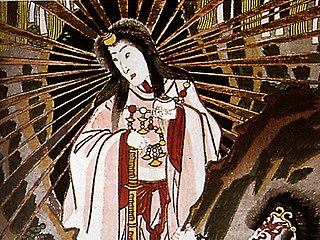
Kusanagi-no-Tsurugi is a legendary Japanese sword and one of three Imperial Regalia of Japan. It was originally called Ame-no-Murakumo-no-Tsurugi, but its name was later changed to the more popular Kusanagi-no-Tsurugi. In folklore, the sword represents the virtue of valor.
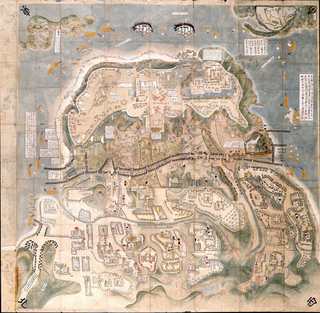
The Shimabara Rebellion, also known as the Shimabara-Amakusa Rebellion or Shimabara-Amakusa Ikki (島原・天草一揆), was an uprising that occurred in the Shimabara Domain of the Tokugawa Shogunate in Japan from 17 December 1637 to 15 April 1638.

Abe no Hirafu was a Japanese military commander, strategist, and politician of the Asuka period.
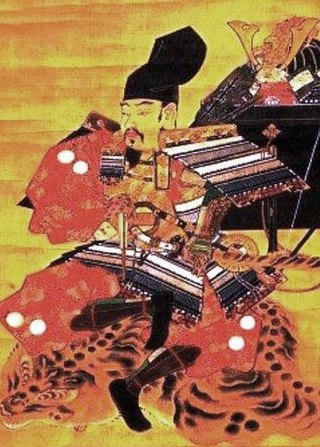
Nitta Yoshisada was a samurai lord of the Nanboku-chō period Japan. He was the head of the Nitta clan in the early fourteenth century, and supported the Southern Court of Emperor Go-Daigo in the Nanboku-chō period. He famously marched on Kamakura, besieging and capturing it from the Hōjō clan in 1333.
Tales of the Otori is a series of historical fantasy novels by Gillian Rubinstein, writing under the pen name Lian Hearn, set in a fictional world based on feudal Japan. The series initially consisted of a trilogy: Across the Nightingale Floor (2002), Grass for His Pillow (2003), and Brilliance of the Moon (2004). It was followed in 2006 by a sequel, The Harsh Cry of the Heron, and in 2007 by a prequel, Heaven's Net is Wide. In 2020, two new books were published in a sequel series called "Children of the Otori", Orphan Warriors and Sibling Assassins.

Across the Nightingale Floor is the first of Lian Hearn's Tales of the Otori trilogy, first published in 2002.

Yatagarasu is a mythical crow and a guiding god in Shinto mythology. During Emperor Jimmu's Eastern Expedition, he was guided from the Kumano Region to Yamato Province by Yatagarasu, who was sent by Takamimusubi. He is generally known for his three-legged figure, and his picture has been handed down since ancient times. The word means (八咫烏, "eight-span crow") and the appearance of the great bird is construed as evidence of the will of Heaven or divine intervention in human affairs.

The Satake clan was a Japanese samurai clan that claimed descent from the Minamoto clan. Its first power base was in Hitachi Province. The clan was subdued by Minamoto no Yoritomo in the late 12th century, but later entered Yoritomo's service as vassals. In the Muromachi period, the Satake served as Governor (shugo) of Hitachi Province, under the aegis of the Ashikaga shogunate. The clan sided with the Western Army during the Battle of Sekigahara, and was punished by Tokugawa Ieyasu, who moved it to a smaller territory in northern Dewa Province at the start of the Edo period. The Satake survived as lords (daimyō) of the Kubota Domain. Over the course of the Edo period, two major branches of the Satake clan were established, one ruled the fief of Iwasaki, the other one the fief of Kubota-Shinden.
The Jinshin War was a war of succession in Japan during the Asuka period of the Yamato state. It broke out in 672 following the death of Emperor Tenji. The name refers to the jinshin (壬申) or ninth year of the sixty-year Jikkan Jūnishi calendrical cycle, corresponding to the Western year 672.

The Ruins of Gorlan is the first novel in the Ranger's Apprentice series written by Australian author John Flanagan. It was first released in Australia on 1 November 2004, and in the United States on 16 June 2005. Flanagan first conceived the world of the novel in a series of short stories he wrote for his son to incite his interest in reading. Ten years later, he decided to turn them into The Ruins of Gorlan, the first book in the Ranger's Apprentice series.
Ranger's Apprentice is a series written by Australian author John Flanagan. The first novel in the series, The Ruins of Gorlan, was released in Australia on 1 November 2004. The books were initially released in Australia and New Zealand, though have since been released in 14 other countries. The series follows the adventures of Will, an orphan who is chosen as an apprentice Ranger, one of the skilled trackers, archers and warriors in the service of the King of Araluen. Will strives to keep the Kingdom of Araluen safe from invaders, traitors, and threats. He is joined on his adventures by his mentor Halt and his best friend Horace.
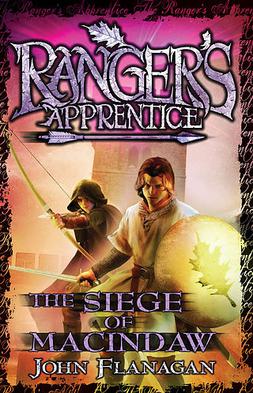
The Siege of Macindaw is the sixth book in the Ranger's Apprentice series by Australian author John Flanagan. The book was first published on 1 May 2007 in Australia and on 4 August 2009 in the United States.

The Lost Stories is the eleventh and penultimate book in the series Ranger's Apprentice by Australian author John Flanagan. It is a collection of "lost" tales that fill in the gaps between novels.

A New Beginning, originally titled The Royal Ranger, was the twelfth and final novel in the Ranger's Apprentice series, written by Australian author John Flanagan. It was released in Australia on 1 October 2013, in New Zealand on 4 October 2013, and in the United States and Canada on 5 November 2013. In 2018, it was renamed A New Beginning and it became the first book in the Ranger's Apprentice sequel series, The Royal Ranger.
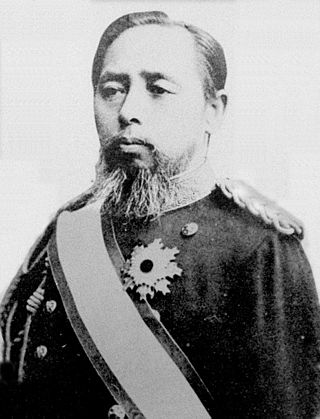
Count Yamada Akiyoshi, was a Japanese statesman, a samurai of Chōshū Domain, and one of the early leaders of the Meiji Restoration. In his youth he was commonly known as Yamada Ichinojō; however, he changed his name frequently during the Bakumatsu period.
















